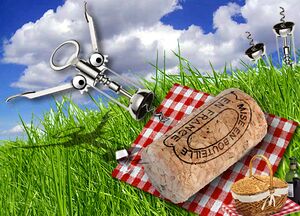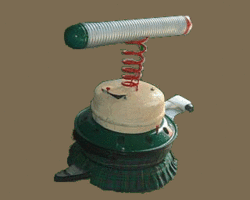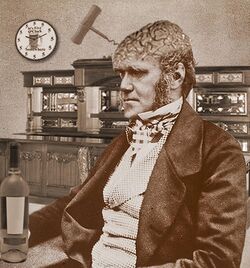Corkscrew
The corkscrew is a macroscopic organism which burrows deep inside the corks of expensive bottles of fine European wines. It is estimated that, during each fiscal year, millions of Euros of wine are lost because of the ravages of corkscrew blight. The corkscrew has little interest in wine per se, preferring instead to feed upon the delicious material of the cork itself (which is extremely high in fiber and exudes many pheromones and other intoxicating aromas).
History of the corkscrew[edit]
Evolutionary origins of the corkscrew[edit]
The evolutionary origins of the corkscrew are lost in the depths of geologic time. However, unbridled speculation strongly suggests that the remote ancestors of the corkscrew may have been far more versatile and deadly, and almost certainly were able to defeat the largest carnivorous dinosaurs by KO within three rounds. It was only with the advent of rancid cheese and stale crackers in 1786 that wild corkscrews finally decided to settle down and live a leisurely life filled with quiet conversations and contemplative philosophical reflection.
[edit]
The corkscrew was discovered casually noticed in 1787 by Lord Pierré Robespierré du Champagné, a French nobleman and official wine taster to Louis XIIIIII. This discovery unavoidable cliché, unlike many others, was marred by heartrending tragedy: a live corkscrew leaped straight out of Monsiéur Champagné's wineglass, spiraled down his throat, and impaled him right in the left ventricle. As he lay dying of internal hemorrhaging, the unlucky Frenchdude was reported as saying "Aide ! Un tire-bouchon de phase a sauté directement hors de mon verre à vin, s'est développé en spirales en bas de ma gorge, et m'a empalé bien dans le ventricule gauche ! Veuillez téléphoner aux infirmiers immédiatement !" which AltaVista's Babel Fish badly translates as "Holy fuck, I'm screwed!".
The corkscrew's influence on Charles Darwin[edit]
It was during the fateful voyage of the USS Beagle that Charles Darwin put forth the prevailing theory concerning the evolutionary origins of the corkscrew. In his bestselling book On the Origin of Corkscrews by Means of Natural Selection, or How the Favoured Races may Preserve Themselves over the Less Favoured Races by Speaking and Writing in a Thoroughly Pretentious Manner he drew thousands of incredibly detailed illustrations of corkscrews (entirely by hand) and also wrote the following:
“The evolutionary origins of the corkscrew are lost in the depths of geologic time. However, unbridled speculation on my part strongly suggests that the remote ancestors of the corkscrew may have been far more versatile and deadly, and almost certainly were able to defeat the largest carnivorous dinosaurs by KO within three rounds. It was only with the advent of rancid cheese and stale crackers in 1786 that wild corkscrews finally decided to settle down and live a leisurely life filled with quiet conversations and contemplative philosophical reflection. Also, Lamarck is the gay (L0Lz!).”
[edit]
In 1903, the Isle of Cork (a small British colony in the middle of the Indian Subocean) was hit particularly hard by a sudden and unanticipated plague of corkscrew. The indigenous cork farmers could only watch in abject horror as wave after wave of ravenous corkscrew swarms swooped down and turned their vast golden fields of ripening cork into worthless inedible sawdust. The hungry pests then spread unchecked throughout the world's underground network of wine refineries, where they cause no end of havoc to this day.
Curtailing the further spread of corkscrew[edit]
There are many preventative measures that have shown themselves to be highly effective in curtailing corkscrew infestation, such as locking vintage wine bottles in air conditioned vaults and never letting them out, ever, or replacing the valuable cork with cheap metallic screw caps. Whilst the humble screw cap is no less vulnerable to a determined corkscrew than soft corky material, it does render the corkscrew impotent by blunting its razor-sharp genitalia, thereby leaving it unable to reproduce or damage other nearby wine bottles.



